汉译英:段落层次的分析语翻译实践 (1)
- 格式:ppt
- 大小:313.00 KB
- 文档页数:18

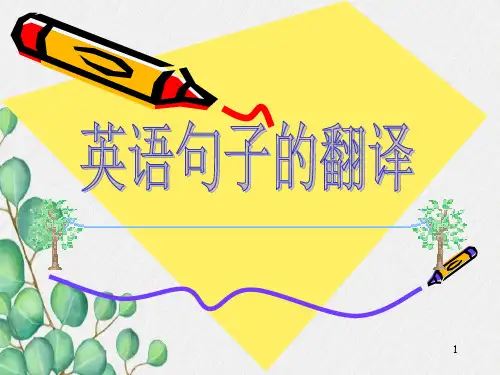

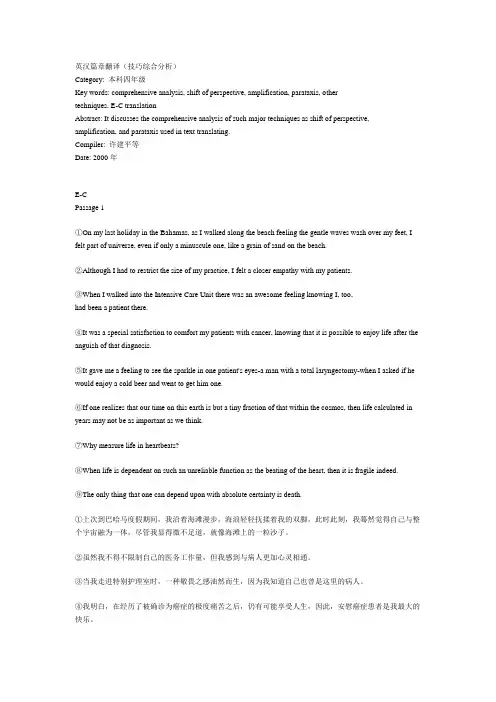
英汉篇章翻译(技巧综合分析)Category: 本科四年级Key words: comprehensive analysis, shift of perspective, amplification, parataxis, othertechniques, E-C translationAbstract: It discusses the comprehensive analysis of such major techniques as shift of perspective, amplification, and parataxis used in text translating.Compiler: 许建平等Date: 2000年E-CPassage 1①On my last holiday in the Bahamas, as I walked along the beach feeling the gentle waves wash over my feet, I felt part of universe, even if only a minuscule one, like a grain of sand on the beach.②Although I had to restrict the size of my practice, I felt a closer empathy with my patients.③When I walked into the Intensive Care Unit there was an awesome feeling knowing I, too,had been a patient there.④It was a special satisfaction to comfort my patients with cancer, knowing that it is possible to enjoy life after the anguish of that diagnosis.⑤It gave me a feeling to see the sparkle in one patient's eyes-a man with a total laryngectomy-when I asked if he would enjoy a cold beer and went to get him one.⑥If one realizes that our time on this earth is but a tiny fraction of that within the cosmos, then life calculated in years may not be as important as we think.⑦Why measure life in heartbeats?⑧When life is dependent on such an unreliable function as the beating of the heart, then it is fragile indeed.⑨The only thing that one can depend upon with absolute certainty is death.①上次到巴哈马度假期间,我沿着海滩漫步,海浪轻轻抚揉着我的双脚,此时此刻,我蓦然觉得自己与整个宇宙融为一体,尽管我显得微不足道,就像海滩上的一粒沙子。
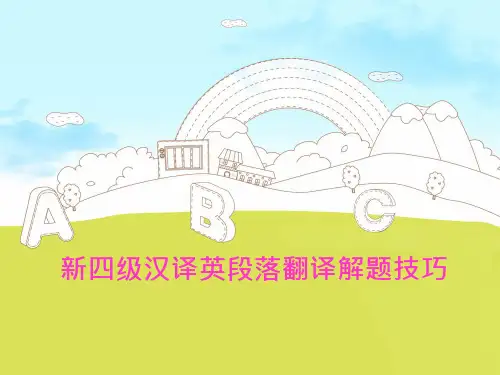
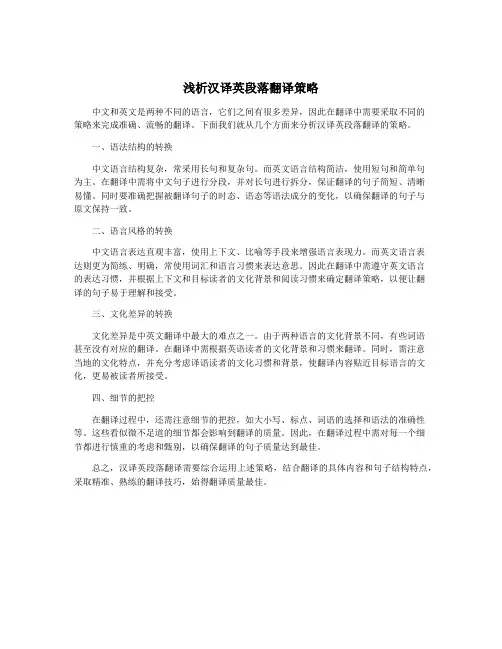
浅析汉译英段落翻译策略中文和英文是两种不同的语言,它们之间有很多差异,因此在翻译中需要采取不同的策略来完成准确、流畅的翻译。
下面我们就从几个方面来分析汉译英段落翻译的策略。
一、语法结构的转换中文语言结构复杂,常采用长句和复杂句。
而英文语言结构简洁,使用短句和简单句为主。
在翻译中需将中文句子进行分段,并对长句进行拆分,保证翻译的句子简短、清晰易懂。
同时要准确把握被翻译句子的时态、语态等语法成分的变化,以确保翻译的句子与原文保持一致。
二、语言风格的转换中文语言表达直观丰富,使用上下文、比喻等手段来增强语言表现力。
而英文语言表达则更为简练、明确,常使用词汇和语言习惯来表达意思。
因此在翻译中需遵守英文语言的表达习惯,并根据上下文和目标读者的文化背景和阅读习惯来确定翻译策略,以便让翻译的句子易于理解和接受。
三、文化差异的转换文化差异是中英文翻译中最大的难点之一。
由于两种语言的文化背景不同,有些词语甚至没有对应的翻译。
在翻译中需根据英语读者的文化背景和习惯来翻译。
同时,需注意当地的文化特点,并充分考虑译语读者的文化习惯和背景,使翻译内容贴近目标语言的文化,更易被读者所接受。
四、细节的把控在翻译过程中,还需注意细节的把控,如大小写、标点、词语的选择和语法的准确性等。
这些看似微不足道的细节都会影响到翻译的质量。
因此,在翻译过程中需对每一个细节都进行慎重的考虑和甄别,以确保翻译的句子质量达到最佳。
总之,汉译英段落翻译需要综合运用上述策略,结合翻译的具体内容和句子结构特点,采取精准、熟练的翻译技巧,始得翻译质量最佳。
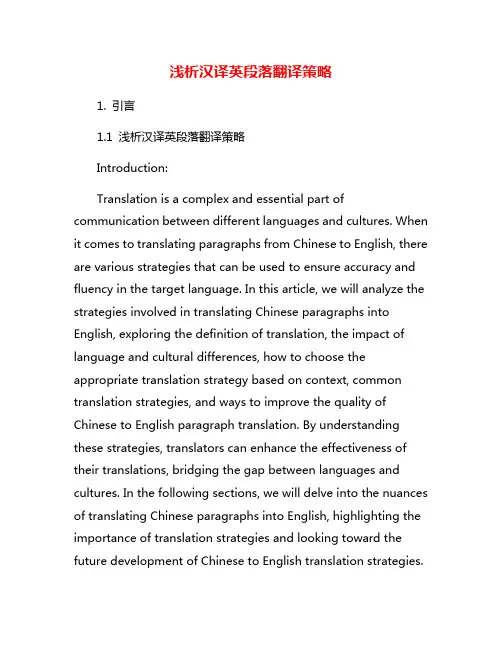
浅析汉译英段落翻译策略1. 引言1.1 浅析汉译英段落翻译策略Introduction:Translation is a complex and essential part of communication between different languages and cultures. When it comes to translating paragraphs from Chinese to English, there are various strategies that can be used to ensure accuracy and fluency in the target language. In this article, we will analyze the strategies involved in translating Chinese paragraphs into English, exploring the definition of translation, the impact of language and cultural differences, how to choose the appropriate translation strategy based on context, common translation strategies, and ways to improve the quality of Chinese to English paragraph translation. By understanding these strategies, translators can enhance the effectiveness of their translations, bridging the gap between languages and cultures. In the following sections, we will delve into the nuances of translating Chinese paragraphs into English, highlighting the importance of translation strategies and looking toward the future development of Chinese to English translation strategies.2. 正文2.1 翻译的定义与重要性The importance of translation cannot be overstated in today's globalized world where businesses, governments, and individuals interact on a global scale. Whether it is translating legal documents, marketing materials, academic papers, or literary works, accurate and effective translation is essential for conveying ideas, information, and emotions across language barriers.2.2 语言和文化差异对翻译的影响Language and cultural differences play a significant role in translation, as they can greatly impact the accuracy and effectiveness of the translated text. It is important for translators to be aware of these differences and to consider them carefully when translating from Chinese to English.One of the main ways in which language and cultural differences affect translation is through the use of idiomatic expressions and cultural references. Idioms, proverbs, and cultural references are often deeply rooted in the language and culture of a particular country, and may not have direct equivalents in the target language. When translating fromChinese to English, for example, a translator may struggle to find an appropriate English equivalent for a Chinese idiom, leading to potential misunderstandings or inaccuracies in the translation.Another way in which language and cultural differences impact translation is through the use of word choice and sentence structure. Chinese and English have different grammatical structures and syntax, which can make it challenging to accurately convey the meaning of a Chinese sentence in English. Translators must carefully consider the nuances of both languages in order to produce a well-written and accurate translation.Furthermore, cultural differences can also influence the tone and style of a translated text. What may be considered polite or formal language in Chinese may not have the same connotations in English, leading to potential misinterpretations of the original meaning. Translators must be sensitive to these cultural nuances in order to produce a translation that accurately reflects the tone and intent of the original text.In conclusion, language and cultural differences have a significant impact on the translation process from Chinese to English. Translators must be aware of these differences and approach the task with care and attention in order to produce ahigh-quality and accurate translation. By taking into account the nuances of both languages and cultures, translators can ensure that the meaning and tone of the original text are preserved in the translated version.2.3 如何根据语境选择合适的翻译策略如何根据语境选择合适的翻译策略非常重要,因为语境能够提供译者丰富的信息和线索,帮助他们准确理解原文意思并选择合适的表达方式。
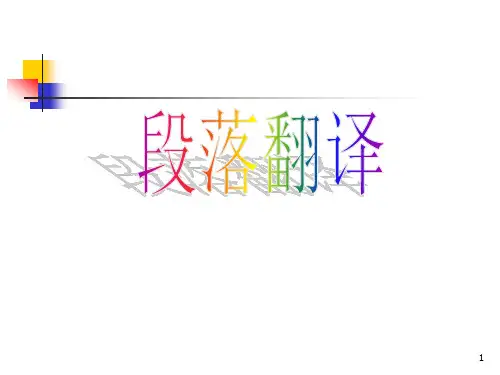

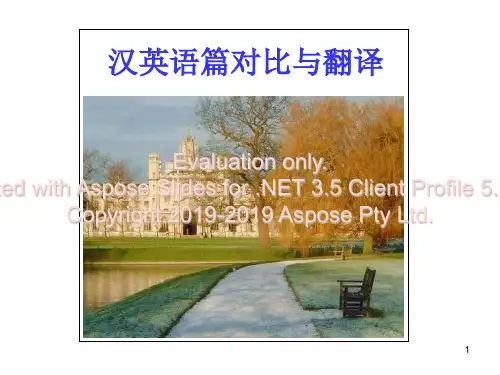
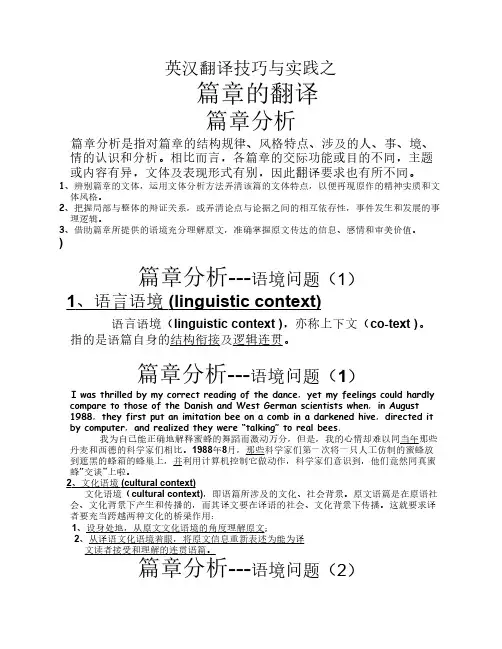
Part II段落翻译与实践I. 汉译英1.和平统一1)促进统一,就要有个适当的方式。
2)所以我们建议举行两党平等会谈,实行第三次合作。
3)大陆和台湾有不同的意识形态,实行不同的政治制度,但绝不能让这一点妨碍我们发展两岸关系,实现和平统一的大业。
1)To promote the reunification of the motherland, we must find a proper means.2) So we suggest that the two Parties hold a talk on an equal footing and try for a third-time cooperation. 3) The fact the mainland and Taiwan have adopted different ideologies and political systems should not be allowed to stand in the way of developing the relations between two sides of the Taiwan Straits and achieving the peaceful reunification.2.大学生…1)现在大学生的学习压力相当重。
2)除了大四,他们开始找工作了,其余的学生总是忙于学习,而不愿参加校园团体和俱乐部,不愿参加体育锻炼和其他课外活动,不愿与他们的朋友玩玩,不愿关心和学习没有关系的事。
3)总之,他们就像一个机器人。
4)压力大,时间少,功课多。
5)看到同寝室里的人都上图书馆去学习,到深夜闭馆才回,而自己却去看电影,他们就会有一种内疚感。
6)一想到白天什么事都没干,心里就感到不安,会整夜因此睡不着觉。
7)他们学习太紧张,几乎没有时间好好品尝生活,干些其他事,成为一个全面发展的人。
8)读大学使他们失去太多的个人幸福和健康。